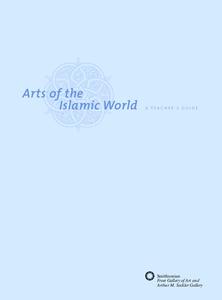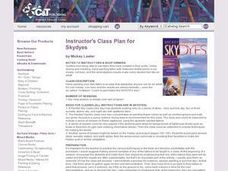Smithsonian Institution
Arts of the Islamic World
Learn more about the history and five pillars of Islam with an extensive resource that focuses on the religion's connection to art. Focusing on calligraphy, textiles, and architecture, the packet illustrates the beauty of the artistic...
Council for Economic Education
Entrepreneurs in Mesopotamia
While ancient Mesopotamia didn't have the TV show "Shark Tank," it was a time of entrepreneurship as workers began to specialize. Both individual workers and the societal structure encouraged individuals to consider how they could...
EngageNY
Introducing Working Conditions in the Mills
Scholars discover how working in a textile mill in the nineteenth century affected the title character from Katherine Paterson's novel, Lyddie. Partners analyze quotes from the novel and then add evidence and questions about working...
EngageNY
Analyzing Textual Evidence: Working Conditions in the Mills
Deafening, dusty, debris. Such were the working conditions in the 1800s textile industry as portrayed in Katherine Paterson's novel Lyddie. Scholars watch a short video clip about life and work in the mills. Next, they work with partners...
Teach Engineering
Nanotechnology in Action: Organic Electronics
Even electronics are going organic. Future engineers learn about organic fibers and their uses in electronics and textiles. Specifically, they study graphene and its properties by creating graphite-based fibers in a laboratory setting...
Curated OER
The Industrial Revolution
Students explore the development of the textile industry in Great Britain. They link the rapid growth in both the textile industry and in coal mining in Great Britain. Students connect the process of industrialization to the expansion of...
Curated OER
Industrialization In Lowell, Massachusetts
Students explore the idealistic expectations of the industrialists who financed and built mills in Lowell, Massachusetts. They research how the expectations of Lowell mill founders compared to the reality of life in the textile mills for...
Curated OER
FACS:Nanotechnology and "Smart" Textiles (IT)
Students obtain an understanding of the term "nanotechnology" and how nanotechnology products be used.
Curated OER
Beginning Sewing Projects
Students practice basic sewing techniques constructing a sewing project.
Curated OER
Vocational: Fashion History
Students research and present reports on 20th century fashions and their influences. After watching a video about fashion, they complete worksheets based on the film. In another activity, students make doll-sized clothing items using...
Global Oneness Project
Rethinking the Fabrics We Wear
What are fibersheds and what what do they have to do with environmental protections? A photo essay and audio recordings about Mimi Luebbermann, and her sheep, cause consumers to reflect on how their clothing choices can support local...
Curated OER
Lesson: Looking Closer: The Artwork of Shinique Smith
A critical discussion regarding the nature of Shinique Smith's second-hand clothing art is the foundation for the lesson. Critical thinkers fully analyze the meaning behind her work, taking close consideration of where the clothing came...
Curated OER
A Sample of What?
Students are introduced to the connection between women and the textile industry. Using primary source documents, they complete a handout on how gender roles have changed over the years. They examine a sampler which is connected to the...
Curated OER
African Asimevo Cloth
Students research and observe the patterns and colors in Asimevo cloh of the Ewe people of Ghana in Africa. They compare the Asimevo cloth to other African textiles, such as Kete, Adinkra, and Kente cloth. They then create visual...
Curated OER
Materials
This interactive presentation is a visual delight for young eyes! The title slide allows you to click on one type of material: wood, fabric, plastic, metal, or paper. You are then taken to a slide to consider numerous objects and...
Curated OER
SKYDYES
Students use fabric they have created in their quilts. Unlike dyeing and marbling, hand-painting fabric with Setacolor textile paints is not messy, not toxic, and the serendipitous results make every student feel like an artist!
Curated OER
FACS: Sewing Factory (Textiles)
Students gain practical experience in how sewing factories are run. They experience job possibilities by running a sewing factory simulation.
Curated OER
Pressing and Seam Finishes
This lesson addresses proper seam allowances, how those seams should be finished, and the importance of pressing them. Class members learn by listening as well as by practicing and creating their own samples. There are many attachments...
Curated OER
Who Done It?
Pick and choose which activities to include in this crime scene investigation. Junior detectives can examine fingerprints, DNA, blood samples, or bone structure. The plan suggests you have teams solve a mystery, but it does not give you...
Curated OER
New England Jeopardy
Jeopardy style games are fun ways to help learners review for tests or solidify concepts recently covered in class. This Jeopardy game focuses on the industrial economy of New England. Students will need to know general information on...
Curated OER
Aztec Art
After looking at some examples of Aztec art and design, learners create some of their own. They use the images in the slideshow as inspiration for the geometric patterns and textures they'll use in their art.
Curated OER
Assessing the Labour Behind the Label
Twelfth graders examine the labor conditions in different companies and corporations. In groups, they use the internet to locate the conditions of the companies of the clothes they are wearing. They share their information with the...
Curated OER
Frieze Design in Indigenous Art
Students describe Frieze designs using the work of indigenous people. In this math lesson, students create 7 frieze designs using different patterns. They create one row of repeated art and repeat this 7 times over to show examples of...
Curated OER
Create a Resist Painting
Students examine the development of resist dye techniques in Japan, Indonesia, and West Africa. They discuss textile decorations and patterns, view examples of batik and dye resist art, and create an original resist painting.
Other popular searches
- Fashion and Textiles
- Clothing & Textiles
- Clothing and Textiles
- African Textiles
- Textiles Technology
- Art Textiles
- Textiles in Ancient China
- Talking Textiles
- Design Textiles
- Fashion and Textiles Cotton
- Fashion and Textiles Starter
- Paper Making and Textiles

























